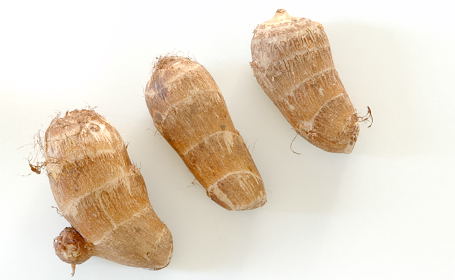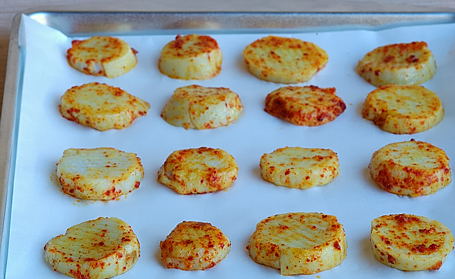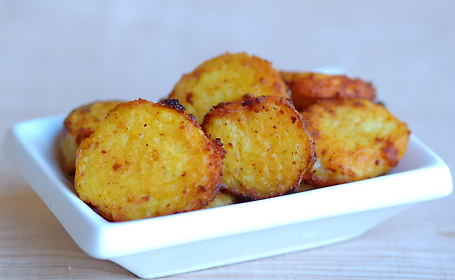
Taro Roots (Chaama Dumpa in Telugu and Arvi in Hindi)
I’ve always found this dish convenient to cook, for I do not have to worry about the stickiness or falling apart at the touch – ness of taro root. Traditionally in India, boiled, sliced taro is fried in an iron skillet on stovetop. Most of times, end result would be a big, shapeless mush. Tastes good but not that appealing to the eyes. Baking and broiling really suits taro. If you haven’t tried it yet, you must now. Perfection, I tell you. Crispy and gold colored, usually forgettable taro becomes an unforgettable taste.
These oven baked chaama dumpa vepudu/fry make a satisfying and nutritious side dish when served with rice and dal/sambar/rasam or yogurt combination. Moreover, it is the ideal dish for these cool winter days. Oven cooking brings that much needed warmth to the home and also to our bellies.

Boiled and sliced taro root (chaama dumpa/arvi) chips ready for baking
Recipe:
Boil (or steam cook) taro roots in water until they become tender. Overboiling makes them extremely mushy so keep checking and remove them before they turn to mushy soft. When they are cooled enough to touch, peel the skins. Cut each, crosswise about quarter to half-inch thickness.
In a vessel, take one or one + (your wish) teaspoons of oil. Add and mix salt, red chilli-garlic powder and turmeric to taste. Add and toss the cut taro root pieces. Spread them in rows neatly on a foil covered baking tray and bake them at 350 F for about 10 minutes. Also broil each side for about 2 to 5 minutes, until they are golden-brown. Remove and serve hot.
While boiling and baking, pay attention to the time and the cooking process. Overcooking in water or overbaking may result in mushy or blackened taro root chips instead of golden, crispy perfection.

Taro root (chaama dumpa/arvi) Chips

Looks good, i will try this if i get to find taro roots…
Good Show…
Comment by Amy — November 16, 2006 @ 6:15 pm
Wha…t! I’m the first to comment! 🙂
Like you said, I am not that great a fan of the sight the mushy goodness. When my mom cooks with taros, somehow the shape holds up decently. Her recipe includes a good quantity of ginger making it that much tastier. I never thought of throwing these in the oven – what a great idea! Thanks for sharing, Indira!
Comment by RD — November 16, 2006 @ 6:18 pm
Aah, maybe not! 😉
Comment by RD — November 16, 2006 @ 6:19 pm
Really! I can do that? I always associated as a slimy veggie. You have changed that.
Comment by Gini — November 16, 2006 @ 6:20 pm
wowow! So very yummy, Indira! Naaku Chamadumpa ante chaala ishtam. I have had the fried version only till now, the common method of preparation in India.Yeah, the mushy version is not very appealing to the eye however it tastes delicious.
I never did a broil of this veggie after coming to the US. Now that you have tried and recommend it, I will definitely give it a shot!Chama Chips…am already hungry to eat them!
Comment by Deepu — November 16, 2006 @ 6:22 pm
nice version of baking Indira, usually, I deep-fry the pieces, will try yours one day.
Comment by lakshmi — November 16, 2006 @ 6:31 pm
This is “Sepankizhangu” or “Chepankuzhangu” in Tamil.
I love taro root, wether they are roasted nice and crispy or soft & mushy in sambars & puli Kuzhambu’s. Will definetely try out ur method. This will make an excellent accompaniment for rasam rice or dal rice. YUMMM!
Comment by Priya S&S — November 16, 2006 @ 7:35 pm
Hi Indira,
I make something very similar, i cut them thin and cook in a non stick pan with some salt and chillie powder. Never tried your way….Next time i will give it a try.
Quick question- do we have to broil them or just baking is good enough?
Madhavi.
Comment by Madhavi — November 16, 2006 @ 7:46 pm
That’s nice Indira. I have never tried baked Arvi. I fry it in non-stick pan with less oil.
Comment by manjubansal — November 16, 2006 @ 9:14 pm
Hi!!
Taro root chips looks so appetizing. Will try it.
Thx for sharing.
Comment by Bhargavi — November 16, 2006 @ 9:15 pm
That looks so mouth-watering. I really like this baking method and this is definitely a must- try. As a visitor from the very early stages of your blog, I congratulate you on your million and more visitors.
Comment by mika — November 16, 2006 @ 9:45 pm
Even to me the only thing that turns me off abt this veggie is the stickiness and I feel guilty frying them too, your recipe seems to be the best way to cook these. Next time thappakunda ivi dorikinappudu try chesthanu !
Comment by Priya — November 16, 2006 @ 9:53 pm
After seeing your karela chips and this one, I regret not buying an oven :(. I will try and get one soon 🙂
By the way, can we bake/broil directly without boiling it first?
Comment by Tweety — November 16, 2006 @ 11:08 pm
This is one of my favorite vegetables. Love Arbi chips. Great pics as usual !
Comment by Krithika — November 17, 2006 @ 4:51 am
yum, I love this vegetable. I usually just roast them in a iron skillet like you described, with a little rice flour. It comes out crispy and golden. Your method of baking/broiling looks so good!
cheers!
Comment by Saffron Hut — November 17, 2006 @ 5:40 am
hi
i love chaama dumpa.the photosnr beautiful. i will definetely try this.thanks for nice recipe.
prameela
Comment by Prameela — November 17, 2006 @ 7:39 am
hi,
I love chaama gada (or dumpa in andhra)
very much. I will definately try this one out.
thanks for the recipe 🙂
Comment by lavanya — November 17, 2006 @ 8:02 am
Thats so innovative! I am always trying to make my food more healthy, and this is a great way to tackle some. Thanks Indira.
Comment by Mystic — November 17, 2006 @ 9:52 am
Taro root, my favourtie veggie!Like you mentioned in the post the two times I tried to make this dish was a mushy oily mass,though it tasted good. Will definitely try this more healthy method. they look so–yummy!
Comment by Nalini — November 17, 2006 @ 10:13 am
This recipe came at a right time. I always would refrain from buy this vegetable as I had to use a lot of oil to fry it. Now I will surely get it and try your version. Thanks.
Comment by Lux — November 17, 2006 @ 10:18 am
Hi,
First time to comment. Great place for recipes. I do the shapeless version of the taroroot, will give this one try next time.
~Usha
Comment by Usha — November 17, 2006 @ 10:55 am
Indira:
My first time to comment. Marvellous job. No one could have done a better job like you.
I too do this the same way and I also add little bit butter on top of them before baking. Butter gives a good gloden color.
Comment by Mahathy — November 17, 2006 @ 12:06 pm
I never tried this, it sounds very interesting.
Comment by krista — November 17, 2006 @ 12:58 pm
Hi Indira,
I always cook arvi in the traditional method and end up with a gooey mass. Thanks for this idea. Will definitely use it in the future.
Comment by Deepz — November 17, 2006 @ 1:58 pm
wow indira, another feast to eyes:)
Comment by supriya — November 17, 2006 @ 3:04 pm
Yum! I love champadumpa veepudu! I didn’t think of sticking it in the oven though. I must try it out.
Comment by Praveena — November 17, 2006 @ 3:45 pm
Hey, thanks all for your nice comments!
Hi Madhavi: Thanks.
If you want little bit crunchiness, you should broil them. Otherwise just baking is enough.
Mika: Without your support and wonderful comments, I’d have never continued blogging. My heartfelt thanks to you for your bloggy friendship! The Green Jackfruit is always special to me, and I really miss you!
Hi Tweety: They have some irritating substance as a layer and old wisdom dictates boiling first. Whatever you do – chips, curry or stew, boil them first, remove the skins and then cook.
Comment by Indira — November 17, 2006 @ 5:10 pm
My husband and I love chamadumpa fry. will definitely try your recipe next time.
Comment by Siri — November 18, 2006 @ 10:42 am
Cool Indira! This method uses up much lesser amount of oil and the dish turns out nice and crispy. Somehow when I cooked the taro root here in the US it always turned out more mushy unless you use lots of oil. I will definitely try this method. Thanks a lot for this recipe.
Comment by Sreekanti — November 18, 2006 @ 10:54 am
My dear Indira
I was hospitalized for a surgery. I am barely okay. Cant do much. Thanks a lot for thinking about me. Just checking whether I forgot to write in English 🙂
Indira replies:
Dearest Inji, sorry to hear about the surgery.
Thank God to hear that you are ok. Thank you for taking the time to leave a comment. Please take plenty of rest, do not worry about a thing, particularly about blogging. If you need anything, mail me, I will do it.
Yay!!! 🙂
I tried to leave a comment at your blog several times, but Blogger is acting up and ate all my comments.:)
I need a big favor, could you please mail me your home address (mailmahanandi@gmail.com). Thanks Dear Inji Pennu.
Best wishes for a speedy recovery!
Comment by InjiPennu — November 18, 2006 @ 11:47 am
hi indira,
i too am really overjoyed and excited to get news about inji. i tried to leave a comment on her blog, but i don’t know if it will work. in case you get in touch with her directly, do convey my regards and deepest concern. i was really worried about not hearing from her.
(it is quite wonderful how we become attached to and concerned about people whom we have never seen, through this internet !) do convey her my best wishes to get better soon and take complete rest.
renu.
Comment by renu — November 19, 2006 @ 1:24 am
Hi Indira
I am so glad to hear about Inji. Please convey our best wishes for a speedy recovery to her. We all missed her!
Comment by mandira — November 20, 2006 @ 6:22 am
Good job Indira! Quite an innovative way. I usually do the chema dumpala pulusu with tamrind concentrate. Tastes delicious. This method of baking will defintely save time.
Comment by srividya p — December 5, 2006 @ 6:40 am
I love taro root(I even love eating it in its boiled form)! I tried this recipe this evening and it has turned out really well – and yes, my taro root has the same golden color that your beautiful picture has :-D! Thank you :-)!
p.s. I boiled the taro root in the pressure cooker for three whistles and then let it cool down completely and then followed the rest of the steps. It did not turn out mushy and it was easier than boiling it in a pan :-)!
Comment by Archana — December 17, 2006 @ 6:49 pm
It’d be great if you could add an estimated time for the initial boiling process… 5 min, 8 min, 10 min… 20 min in salted, rapid boiling water. Maybe suggest a blanching method at this point… boil and have an ice bath ready to go so the cook can place the hot taro root in ice cold water to stop the cooking and loosen the peels! 🙂 You are inspiring to me. That’s not an easy task for a restaurant owner/chef! Thank you!!
Comment by DTosh — April 27, 2007 @ 12:29 am
Once you fry them brown, take a pan with very little oil, put red chilli powder, garam masala powder, coconut powder, dhania powder and salt and mix with incredients in pan with fried chips. You can eat the mixture with hot rice but mixing the incredients which will be like any dry chutlney (kandhi chutney, karivepaku chatney etc.) This is the most common way of cooking chama in Telangana
Comment by Raga Jyothi — June 24, 2007 @ 3:27 pm
Thanks for this recipe. We usually make taro root by frying it which requires so much oil. This was a delicious way to enjoy it while being healthy. It was very yummy with magi mum!
Comment by nithya — October 12, 2007 @ 8:57 am
i’m newly married… & my husband’s the guines pig for all my cookin efforts! 🙂 i tried this recipe today & we just loved it! thank u so much for a healthy alternative…
Comment by Shalini — December 13, 2007 @ 3:18 pm
I just love your recipes….and the way you present them…i have just tried a few and they have turned out to be amazing….
Comment by Padma — November 19, 2008 @ 9:07 am
I LOVE taro root i usually boil and serve with high quality olive oi, slice red oinions and boiled dry cod fish (adding sea salt) excellent. Will try this recipe.
Comment by raquel — August 4, 2010 @ 2:36 pm
[…] Mahanandi » Taro Root / Arvi Chips … – 40 comments for Taro Root / Arvi Chips (Chaamadumpa Vepudu) » Looks good, i will try this if i get to find taro roots… Good Show… Comment by Amy — November 16 …… […]
Pingback by Taro Root Chips | Laatuasunnot — February 28, 2015 @ 2:05 pm
[…] […]
Pingback by Arbi chips recipe | Fried arbi recipe | Taro chips recipe — October 10, 2015 @ 9:55 am